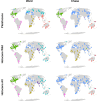Late Pleistocene faunal community patterns disrupted by Holocene human impacts
- PMID: 40795982
- PMCID: PMC12343122
- DOI: 10.1098/rsbl.2025.0151
Late Pleistocene faunal community patterns disrupted by Holocene human impacts
Abstract
We analysed fossil mammal assemblages from over 350 Late Pleistocene and Holocene sites worldwide to test whether human activities, such as agriculture, domestication and intensified land use, restructured global patterns of mammal co-occurrence. Using presence-absence data, we contrasted a novel iterative 'chase clustering' method, which is compositionally driven, against a traditional spatially constrained Ward's clustering approach. Both methods recovered continental-scale groupings in the Pleistocene, consistent with known biogeographic boundaries. Holocene land use and domestication reconfigured these historical patterns, creating novel assemblages independent of previous biogeographic constraints. Faunal turnover at the local scale varied substantially across regions, being especially pronounced in the Americas, whereas other areas showed relative stability. Even moderate expansion of domesticates altered how communities grouped, highlighting their disproportionate ecological influence. Our findings demonstrate that human-driven niche modification, beyond earlier megafaunal extinctions, profoundly reshaped mammal communities on a global scale. Recognizing these anthropogenic legacies provides essential context for anticipating how current and future human pressures might further transform biodiversity.
Keywords: Holocene; agriculture; biogeography; clustering; domestication; faunal turnover; mammal communities; zooarchaeology.
Conflict of interest statement
We declare we have no competing interests.
Figures



References
-
- Ahmad HI, Ahmad MJ, Jabbir F, Ahmar S, Ahmad N, Elokil AA, Chen J. 2020. The domestication makeup: evolution, survival, and challenges. Front. Ecol. Evol. 8, e103. ( 10.3389/fevo.2020.00103) - DOI
MeSH terms
Grants and funding
LinkOut - more resources
Full Text Sources
